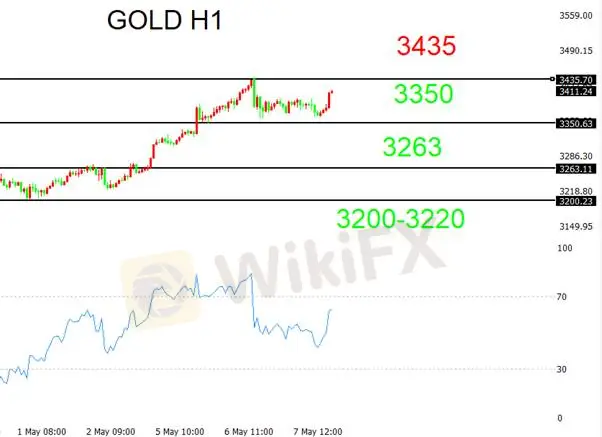简体中文
繁體中文
English
Pусский
日本語
ภาษาไทย
Tiếng Việt
Bahasa Indonesia
Español
हिन्दी
Filippiiniläinen
Français
Deutsch
Português
Türkçe
한국어
العربية
Gold Faces Short-Term Pressure, But Bullish Long-Term Outlook Remains Intact
Abstract:Gold prices extended losses on Wednesday, weighed down by a stronger U.S. dollar and easing geopolitical tensions between the U.S. and China, which curbed safe-haven demand. Adding to the bearish tone
Gold prices extended losses on Wednesday, weighed down by a stronger U.S. dollar and easing geopolitical tensions between the U.S. and China, which curbed safe-haven demand. Adding to the bearish tone, Federal Reserve Chair Jerome Powell's latest comments failed to reassure markets—instead, his cautious view on the economic outlook sparked investor unease. While the Fed held rates steady, its statement flagged, for the first time, a “dual risk” of rising inflation and unemployment, fueling concerns over potential stagflation in the U.S. economy.
The Feds Policy Dilemma
The Fed currently finds itself in a wait-and-see mode. Its policy direction hinges on which macro risk dominates—an employment downturn or a resurgence in inflation. A significant deterioration in the labor market would provide grounds for rate cuts. Conversely, another inflation spike would likely force the Fed to maintain a restrictive stance. The worst-case scenario—simultaneous deterioration in both jobs and prices—would place the central bank in a difficult position, having to weigh the trade-off between inflation control and job protection.
Central Bank Buying: A Key Pillar of Gold Support
Despite short-term headwinds, central bank demand continues to offer a robust foundation for gold prices. Data released Wednesday revealed that the People's Bank of China (PBOC) added approximately 70,000 troy ounces of gold to its reserves in April, pushing its six-month cumulative purchases near 1 million ounces—roughly 30 metric tons.

Bloomberg reports that since early 2024, global central banks have ramped up gold buying in response to escalating geopolitical tensions and a growing desire to diversify away from U.S. dollar assets. Goldman Sachs highlights that, following the 2022 freeze of Russian reserves, central bank gold purchases have increased fivefold. Should the PBOC aim to raise gold reserves from the current 8% to the global average of 20%, it would need to acquire about 40 tons per month over the next three years—underscoring the long-term sustainability of this demand.
Robust Domestic Demand in China
Beyond official purchases, retail demand in China has surged. Gold trading volume on the Shanghai Futures Exchange recently hit all-time highs, reflecting investor confidence in gold as a safe-haven asset. In response to this strong physical demand, the PBOC has issued additional gold import quotas to commercial banks, further fueling the domestic gold market.
U.S.-China Trade Talks Remain a Wild Card
In the near term, the outlook for U.S.-China trade negotiations remains uncertain. To foster a stable environment for talks, Chinese authorities have introduced several pro-growth measures, including policy rate cuts and reductions to banks' reserve requirement ratios. These steps are designed to boost market confidence and indirectly reinforce bullish expectations for gold.
Conclusion: Short-Term Pullback, Long-Term Bullish Setup
While gold prices have come under pressure due to dollar strength and fading geopolitical risks, the long-term bullish structure remains intact. The Feds cautious stance amid dual risks of inflation and unemployment leaves room for policy shifts if labor data weakens or debt markets falter—conditions that would likely renew rate-cut expectations and support a gold rebound. Additionally, sustained central bank accumulation—especially from China—continues to bolster long-term buying interest. Strong domestic demand and relaxed import restrictions in China further enhance physical market resilience. Overall, recent price pullbacks appear to be healthy technical corrections, not a change in trend.
[Gold Price Outlook]

From a technical standpoint, gold has successfully defended the $3,365 level in three consecutive pullbacks, signaling strong support. As a result, we raise our short-term support target from $3,350 to $3,365. This new technical base, combined with ongoing central bank buying and policy uncertainty from the Fed, reinforces the bullish bias. A breakout above the $3,435 resistance level could trigger a new upward leg. We recommend investors hold core long positions, take profits in stages at higher levels, and increase exposure upon a confirmed breakout—favoring a momentum-based right-side trading strategy.
Resistance: $3,435/oz
Support: $3,200–20 / $3,263 / $3,365 per oz
Risk Disclaimer: The above analysis, opinions, research, prices, or other information are provided as general market commentary and do not constitute investment advice. Readers assume full responsibility for their trading decisions. Please proceed with caution.
Disclaimer:
The views in this article only represent the author's personal views, and do not constitute investment advice on this platform. This platform does not guarantee the accuracy, completeness and timeliness of the information in the article, and will not be liable for any loss caused by the use of or reliance on the information in the article.
WikiFX Broker
Latest News
Promax Trading Exposed with Account Disabling and Scam Allegations
Who Are the Cybercriminals Behind the Darcula Phishing Network?
Meta Cracks Down on Scam Networks Targeting Brazil and India
Clicking on a Facebook Ad Cost Him His Life Savings of RM186,800
Are You Trading or Are You Gambling?
EUR/USD at a Critical Juncture: Can the 1.13 Level Hold?
XNT Group Broker Review
Warren Buffett’s 5 Golden Rules that Every Trader Must Know
XM Marks 15 Years in Trading with New Product Launches and Events
Mastering Trading Psychology: Four Pillars of Mental Strength for Market Participants
Currency Calculator


